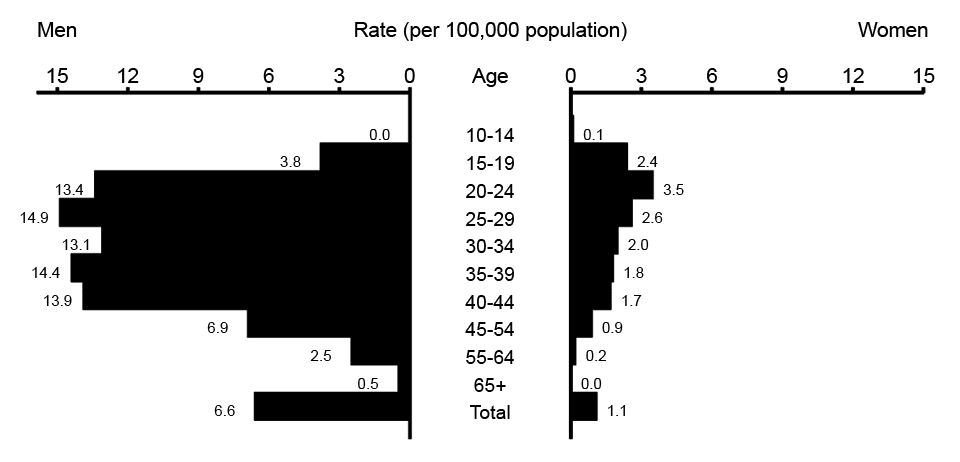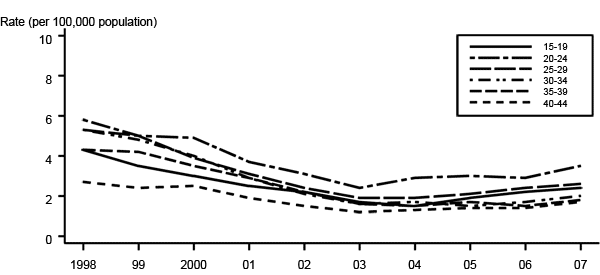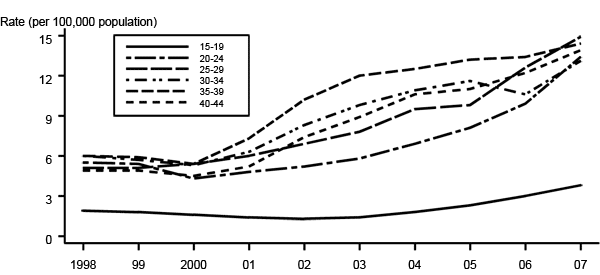Syphilis epidemiology and demographics: Difference between revisions
No edit summary |
No edit summary |
||
| Line 1: | Line 1: | ||
==Overview== | ==Overview== | ||
The rate of primary and secondary syphilis reported in the United States decreased during the 1990s; in 2000, the rate was the lowest since reporting began in 1941. The low rate of infectious syphilis and the concentration of the majority of syphilis cases in a small number of geographic areas in the United States led to the development of the CDCs National Plan to Eliminate Syphilis, which was announced by Surgeon General David Satcher in October 1999 and revised in May 2006.[http://www.cdc.gov/stopsyphilis/plan.htm 2] | The rate of primary and secondary syphilis reported in the United States decreased during the 1990s; in 2000, the rate was the lowest since reporting began in 1941. The low rate of infectious syphilis and the concentration of the majority of syphilis cases in a small number of geographic areas in the United States led to the development of the CDCs National Plan to Eliminate Syphilis, which was announced by Surgeon General David Satcher in October 1999 and revised in May 2006.[http://www.cdc.gov/stopsyphilis/plan.htm 2] | ||
| Line 8: | Line 6: | ||
Syphilis remains an important problem in the South and in urban areas in other regions of the country. Increases in cases among MSM have occurred and have been characterized by high rates of HIV co-infection and high-risk sexual behavior.3-7 The estimated proportion of primary and secondary syphilis cases attributable to MSM increased from 4% in 2000 to 62% in 2004. In 2005, CDC requested that all state health departments report sex of sex partners for persons with syphilis. In 2007, 65% of those primary and secondary syphilis cases in 44 states and Washington D.C. with available information were among MSM. Of reported male cases with primary and secondary syphilis, sex of partner information in 2007 was available for 79%. | Syphilis remains an important problem in the South and in urban areas in other regions of the country. Increases in cases among MSM have occurred and have been characterized by high rates of HIV co-infection and high-risk sexual behavior.3-7 The estimated proportion of primary and secondary syphilis cases attributable to MSM increased from 4% in 2000 to 62% in 2004. In 2005, CDC requested that all state health departments report sex of sex partners for persons with syphilis. In 2007, 65% of those primary and secondary syphilis cases in 44 states and Washington D.C. with available information were among MSM. Of reported male cases with primary and secondary syphilis, sex of partner information in 2007 was available for 79%. | ||
==Syphilis: All Stages== | Syphilis, a genital ulcerative disease, causes significant complications if untreated and facilitates the transmission of [[HIV]]. Untreated early syphilis in pregnant women results in perinatal death in up to 40% of cases and, if acquired during the four years preceding pregnancy, may lead to infection of the fetus in 80% of cases.<ref name="pmid14829195">{{cite journal |author=INGRAHAM NR |title=The value of penicillin alone in the prevention and treatment of congenital syphilis |journal=[[Acta Dermato-venereologica. Supplementum]] |volume=31 |issue=Suppl. 24 |pages=60–87 |year=1950 |pmid=14829195 |doi= |url= |accessdate=2012-02-10}}</ref> | ||
==Epidemiolgoy and Demographics== | |||
===Syphilis: All Stages=== | |||
Depending on the different manifestations that occur depending on the stage of the disease, syphilis is classified into primary & secondary, early latent, late, late latent and congenital. | Depending on the different manifestations that occur depending on the stage of the disease, syphilis is classified into primary & secondary, early latent, late, late latent and congenital. | ||
Between 2006 and 2007, the number of cases of early latent syphilis reported to CDC increased 17.2% (from 9,186 to 10,768), while the number of cases of late and late latent syphilis increased 3.5% (from 17,644 to 18,256)[http://www.cdc.gov/std/stats07/tables/1.htm 3]. The total number of cases of syphilis (all stages: primary and secondary, early latent, late, late latent, and congenital syphilis) reported to CDC increased 10.7% (from 36, 959 to 40, 920) between 2006 and 2007 [http://www.cdc.gov/std/stats07/tables/1.htm 3]. | Between 2006 and 2007, the number of cases of early latent syphilis reported to CDC increased 17.2% (from 9,186 to 10,768), while the number of cases of late and late latent syphilis increased 3.5% (from 17,644 to 18,256)[http://www.cdc.gov/std/stats07/tables/1.htm 3]. The total number of cases of syphilis (all stages: primary and secondary, early latent, late, late latent, and congenital syphilis) reported to CDC increased 10.7% (from 36, 959 to 40, 920) between 2006 and 2007 [http://www.cdc.gov/std/stats07/tables/1.htm 3]. | ||
==Primary | ===Primary and Secondary Syphilis: United States=== | ||
In 2007, primary and secondary syphilis cases reported to CDC increased to 11,466 from 9,756 in 2006, an increase of 17.5%. The rate of primary and secondary syphilis in the United States in 2007 (3.8 cases per 100,000 population) was 15.2% higher than the rate in 2006 (3.3 cases per 100,000 population), and it is greater than the HP 2010 target of 0.2 case per 100,000 population [http://www.cdc.gov/std/stats07/tables/1.htm 3]. | In 2007, primary and secondary syphilis cases reported to CDC increased to 11,466 from 9,756 in 2006, an increase of 17.5%. The rate of primary and secondary syphilis in the United States in 2007 (3.8 cases per 100,000 population) was 15.2% higher than the rate in 2006 (3.3 cases per 100,000 population), and it is greater than the HP 2010 target of 0.2 case per 100,000 population [http://www.cdc.gov/std/stats07/tables/1.htm 3]. | ||
[[File:Primary and secondary syphilis rates.gif|thumb|Note: The Healthy People 2010 target for primary & secondary syphilis is 0.2 case per 100,000 population.|left|650px]]<br clear="left"/> | [[File:Primary and secondary syphilis rates.gif|thumb|Note: The Healthy People 2010 target for primary & secondary syphilis is 0.2 case per 100,000 population.|left|650px]]<br clear="left"/> | ||
===By Region=== | ====By Region==== | ||
The South accounted for 48.8% of the primary and secondary syphilis cases in 2007 and 47.1% in 2006. Between 2006 and 2007, rates increased 21.4% in the South (from 4.2 to 5.1 cases per 100,000 population), 30.8% in the Northeast (from 2.6 to 3.4), 8.1% in the West (from 3.7 to 4.0) and 5.6% in the Midwest (from 1.8 to 1.9). The 2007 rates in all regions were greater than the HP 2010 target of 0.2 cases per 100,000 population [http://www.cdc.gov/std/stats07/tables/25.htm 4]. | The South accounted for 48.8% of the primary and secondary syphilis cases in 2007 and 47.1% in 2006. Between 2006 and 2007, rates increased 21.4% in the South (from 4.2 to 5.1 cases per 100,000 population), 30.8% in the Northeast (from 2.6 to 3.4), 8.1% in the West (from 3.7 to 4.0) and 5.6% in the Midwest (from 1.8 to 1.9). The 2007 rates in all regions were greater than the HP 2010 target of 0.2 cases per 100,000 population [http://www.cdc.gov/std/stats07/tables/25.htm 4]. | ||
[[File:Primary and secondary syphilis rates by region.gif|thumb|Note: The Healthy People 2010 target for primary & secondary syphilis is 0.2 case per 100,000 population.|left|650px]]<br clear="left"/> | [[File:Primary and secondary syphilis rates by region.gif|thumb|Note: The Healthy People 2010 target for primary & secondary syphilis is 0.2 case per 100,000 population.|left|650px]]<br clear="left"/> | ||
===By State=== | ====By State==== | ||
In 2007, primary and secondary syphilis rates in three states were less than or equal to the HP 2010 target of 0.2 case per 100,000 population [http://www.cdc.gov/std/stats07/tables/24.htm 5]. Four states and one outlying area reported five or fewer cases of P&S syphilis in 2007 [http://www.cdc.gov/std/stats07/tables/24.htm 5]. | In 2007, primary and secondary syphilis rates in three states were less than or equal to the HP 2010 target of 0.2 case per 100,000 population [http://www.cdc.gov/std/stats07/tables/24.htm 5]. Four states and one outlying area reported five or fewer cases of P&S syphilis in 2007 [http://www.cdc.gov/std/stats07/tables/24.htm 5]. | ||
[[File:Primary and secondary syphilis rates by state.gif|thumb|Note: The total rate of primary & secondary syphilis for the United States and outlying areas (Guam, Puerto Rico and Virgin Islands) was 3.8 per 100,000 population. The Healthy People 2010 target is 0.2 case per 100,000 population.|left|650px]]<br clear="left"/> | [[File:Primary and secondary syphilis rates by state.gif|thumb|Note: The total rate of primary & secondary syphilis for the United States and outlying areas (Guam, Puerto Rico and Virgin Islands) was 3.8 per 100,000 population. The Healthy People 2010 target is 0.2 case per 100,000 population.|left|650px]]<br clear="left"/> | ||
===By Metropolitan Statistical Area (MSA)=== | ====By Metropolitan Statistical Area (MSA)==== | ||
The rate of primary and secondary syphilis in 2007 for the 50 most populous MSAs (5.7) exceeded the HP 2010 target of 0.2 cases per 100,000 population [http://www.cdc.gov/std/stats07/tables/28.htm 6]. | The rate of primary and secondary syphilis in 2007 for the 50 most populous MSAs (5.7) exceeded the HP 2010 target of 0.2 cases per 100,000 population [http://www.cdc.gov/std/stats07/tables/28.htm 6]. | ||
| Line 36: | Line 37: | ||
[[File:Primary and secondary syphilis rates by county.gif|thumb|Note: The Healthy People 2010 target for primary and secondary syphilis is 0.2 case per 100,000 population. In 2007, 2,274 (72.4%) of 3,140 counties in the U.S. reported no cases of primary and secondary syphilis.|left|650px]]<br clear="left"/> | [[File:Primary and secondary syphilis rates by county.gif|thumb|Note: The Healthy People 2010 target for primary and secondary syphilis is 0.2 case per 100,000 population. In 2007, 2,274 (72.4%) of 3,140 counties in the U.S. reported no cases of primary and secondary syphilis.|left|650px]]<br clear="left"/> | ||
==Age== | ===Age=== | ||
In 2007, the rate of primary and secondary syphilis was highest in persons in the 25- to 29-year-old age group (8.9 cases per 100,000 population)[http://www.cdc.gov/std/stats07/tables/32.htm 8]. | In 2007, the rate of primary and secondary syphilis was highest in persons in the 25- to 29-year-old age group (8.9 cases per 100,000 population)[http://www.cdc.gov/std/stats07/tables/32.htm 8]. | ||
| Line 49: | Line 50: | ||
</gallery> | </gallery> | ||
==Impact of Gender== | ===Impact of Gender=== | ||
The rate of primary and secondary syphilis increased 17.9% among men (from 5.6 cases to 6.6 cases per 100,000 men) between 2006 and 2007 [http://www.cdc.gov/std/stats07/tables/27.htm 9]. During this time, the rate increased 10.0% among women from 1.0 to 1.1 cases per 100,000 women [http://www.cdc.gov/std/stats07/tables/26.htm 10]. | The rate of primary and secondary syphilis increased 17.9% among men (from 5.6 cases to 6.6 cases per 100,000 men) between 2006 and 2007 [http://www.cdc.gov/std/stats07/tables/27.htm 9]. During this time, the rate increased 10.0% among women from 1.0 to 1.1 cases per 100,000 women [http://www.cdc.gov/std/stats07/tables/26.htm 10]. | ||
====By Sex & Sex Behavior==== | =====By Sex & Sex Behavior===== | ||
The male to female rate ratio for primary and secondary syphilis has risen steadily since 1996 when it was 1.2, suggesting an increase among MSM. In 2007, the rate of primary and secondary syphilis in males was 6.0 times that in females, an increase from 5.7 in 2006. | The male to female rate ratio for primary and secondary syphilis has risen steadily since 1996 when it was 1.2, suggesting an increase among MSM. In 2007, the rate of primary and secondary syphilis in males was 6.0 times that in females, an increase from 5.7 in 2006. | ||
| Line 61: | Line 62: | ||
Of females with primary and secondary syphilis, 21.9% were white, 63.5% were black, 9.6% were Hispanic, and 5.0% were of other races/ethnicities. Of heterosexual men, 19.3% were white, 59.8% were black, 16.1% were Hispanic, and 4.8% were of other race/ethnicities. Of men who had sex with men, 40.8% were white, 33.2% were black, 19.3% were Hispanic, and 6.7% were of other races/ethnicities. | Of females with primary and secondary syphilis, 21.9% were white, 63.5% were black, 9.6% were Hispanic, and 5.0% were of other races/ethnicities. Of heterosexual men, 19.3% were white, 59.8% were black, 16.1% were Hispanic, and 4.8% were of other race/ethnicities. Of men who had sex with men, 40.8% were white, 33.2% were black, 19.3% were Hispanic, and 6.7% were of other races/ethnicities. | ||
==Race | ===Race and Ethnicity=== | ||
From 2006 to 2007, the rate of primary and secondary syphilis increased in all racial and ethnic groups except Asian/Pacific Islanders. The rate increased 5.3% among non-Hispanic whites (from 1.9 to 2.0), 25% among blacks (from 11.2 to 14.0), 22.9% among Hispanics (from 3.5 to 4.3), and 6.3% among American Indian/Alaska Natives (from 3.2 to 3.4). The rate remained the same at 1.2 cases per 100,000 population among Asian/Pacific Islanders [http://www.cdc.gov/std/stats07/tables/33b.htm 11]. | From 2006 to 2007, the rate of primary and secondary syphilis increased in all racial and ethnic groups except Asian/Pacific Islanders. The rate increased 5.3% among non-Hispanic whites (from 1.9 to 2.0), 25% among blacks (from 11.2 to 14.0), 22.9% among Hispanics (from 3.5 to 4.3), and 6.3% among American Indian/Alaska Natives (from 3.2 to 3.4). The rate remained the same at 1.2 cases per 100,000 population among Asian/Pacific Islanders [http://www.cdc.gov/std/stats07/tables/33b.htm 11]. | ||
| Line 69: | Line 70: | ||
====By Race/Ethnicity, Age, and Sex==== | ====By Race/Ethnicity, Age, and Sex==== | ||
In 2007, the rate of primary and secondary syphilis among blacks was highest among women aged 20 to 24 years (16.0) and among men aged 20 to 24 years (57.5) and 25 to 29 years (57.4). For non-Hispanic whites, the rate was highest among women aged 20 to 24 years (1.1) and among men aged 40 to 44 years (10.4). For Hispanics, the rate was highest among women aged 20 to 24 years (2.3) and among men aged 40 to 44 years (15.5). For Asian/Pacific Islanders, the rate was highest among women aged 20 to 24 years and 30 to 34 years (both 0.4) and among men aged 25 to 29 years (5.8). For American Indian/Alaska Natives, the rate was highest among women aged 25 to 29 years (7.8) and among men aged 30 to 34 years (18.2) [http://www.cdc.gov/std/stats07/tables/33b.htm 11]. | In 2007, the rate of primary and secondary syphilis among blacks was highest among women aged 20 to 24 years (16.0) and among men aged 20 to 24 years (57.5) and 25 to 29 years (57.4). For non-Hispanic whites, the rate was highest among women aged 20 to 24 years (1.1) and among men aged 40 to 44 years (10.4). For Hispanics, the rate was highest among women aged 20 to 24 years (2.3) and among men aged 40 to 44 years (15.5). For Asian/Pacific Islanders, the rate was highest among women aged 20 to 24 years and 30 to 34 years (both 0.4) and among men aged 25 to 29 years (5.8). For American Indian/Alaska Natives, the rate was highest among women aged 25 to 29 years (7.8) and among men aged 30 to 34 years (18.2) [http://www.cdc.gov/std/stats07/tables/33b.htm 11]. | ||
==References== | ==References== | ||
| Line 82: | Line 80: | ||
[[Category:Gynecology]] | [[Category:Gynecology]] | ||
[[Category:Infectious disease]] | [[Category:Infectious disease]] | ||
[[Category:Bacterial diseases]] | |||
[[Category:Sexually transmitted diseases]] | |||
Revision as of 16:17, 17 December 2012
Overview
The rate of primary and secondary syphilis reported in the United States decreased during the 1990s; in 2000, the rate was the lowest since reporting began in 1941. The low rate of infectious syphilis and the concentration of the majority of syphilis cases in a small number of geographic areas in the United States led to the development of the CDCs National Plan to Eliminate Syphilis, which was announced by Surgeon General David Satcher in October 1999 and revised in May 2006.2
Although the rate of primary and secondary syphilis in the United States declined 89.7% between 1990 and 2000, the rate of primary and secondary syphilis increased annually between 2001 and 2007. Overall increases in rates between 2001 and 2007 were observed primarily among men (from 3.0 cases per 100,000 population to 6.6 cases per 100,000 population). After persistent declines from 1992 to 2003, the rate of primary and secondary syphilis among women increased from 0.8 cases per 100,000 population in 2004 to 0.9 cases per 100,000 population in 2005 to 1.0 case per 100,000 population in 2006, to 1.1 case per 100,000 population in 2007.
Syphilis remains an important problem in the South and in urban areas in other regions of the country. Increases in cases among MSM have occurred and have been characterized by high rates of HIV co-infection and high-risk sexual behavior.3-7 The estimated proportion of primary and secondary syphilis cases attributable to MSM increased from 4% in 2000 to 62% in 2004. In 2005, CDC requested that all state health departments report sex of sex partners for persons with syphilis. In 2007, 65% of those primary and secondary syphilis cases in 44 states and Washington D.C. with available information were among MSM. Of reported male cases with primary and secondary syphilis, sex of partner information in 2007 was available for 79%.
Syphilis, a genital ulcerative disease, causes significant complications if untreated and facilitates the transmission of HIV. Untreated early syphilis in pregnant women results in perinatal death in up to 40% of cases and, if acquired during the four years preceding pregnancy, may lead to infection of the fetus in 80% of cases.[1]
Epidemiolgoy and Demographics
Syphilis: All Stages
Depending on the different manifestations that occur depending on the stage of the disease, syphilis is classified into primary & secondary, early latent, late, late latent and congenital.
Between 2006 and 2007, the number of cases of early latent syphilis reported to CDC increased 17.2% (from 9,186 to 10,768), while the number of cases of late and late latent syphilis increased 3.5% (from 17,644 to 18,256)3. The total number of cases of syphilis (all stages: primary and secondary, early latent, late, late latent, and congenital syphilis) reported to CDC increased 10.7% (from 36, 959 to 40, 920) between 2006 and 2007 3.
Primary and Secondary Syphilis: United States
In 2007, primary and secondary syphilis cases reported to CDC increased to 11,466 from 9,756 in 2006, an increase of 17.5%. The rate of primary and secondary syphilis in the United States in 2007 (3.8 cases per 100,000 population) was 15.2% higher than the rate in 2006 (3.3 cases per 100,000 population), and it is greater than the HP 2010 target of 0.2 case per 100,000 population 3.
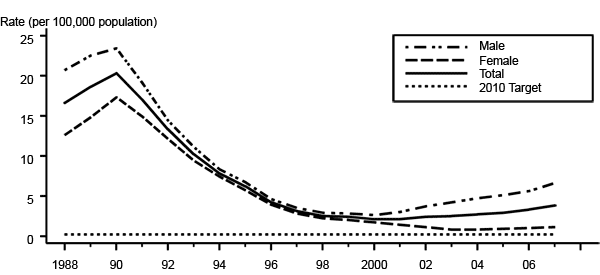
By Region
The South accounted for 48.8% of the primary and secondary syphilis cases in 2007 and 47.1% in 2006. Between 2006 and 2007, rates increased 21.4% in the South (from 4.2 to 5.1 cases per 100,000 population), 30.8% in the Northeast (from 2.6 to 3.4), 8.1% in the West (from 3.7 to 4.0) and 5.6% in the Midwest (from 1.8 to 1.9). The 2007 rates in all regions were greater than the HP 2010 target of 0.2 cases per 100,000 population 4.

By State
In 2007, primary and secondary syphilis rates in three states were less than or equal to the HP 2010 target of 0.2 case per 100,000 population 5. Four states and one outlying area reported five or fewer cases of P&S syphilis in 2007 5.
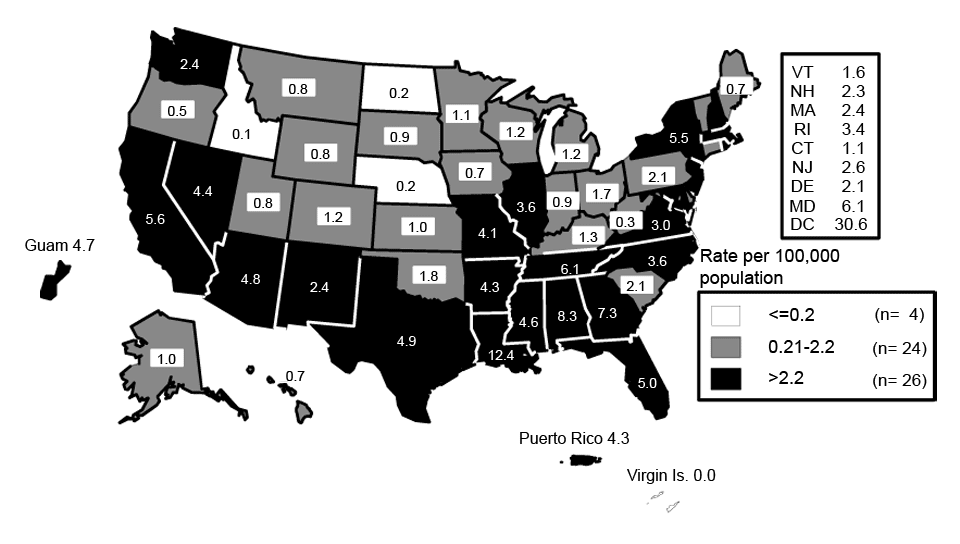
By Metropolitan Statistical Area (MSA)
The rate of primary and secondary syphilis in 2007 for the 50 most populous MSAs (5.7) exceeded the HP 2010 target of 0.2 cases per 100,000 population 6.
By Country
In 2007, 2,275 of 3,140 counties (72.4%) in the United States reported no cases of primary and secondary syphilis compared with 2,360 (75.2%) in 2006. Of 865 counties reporting at least one case of primary and secondary syphilis in 2007, five (0.6%) had rates at or below the HP2010 target of 0.2 cases per 100,000 population. Rates of primary and secondary syphilis were above the HP2010 target for 860 counties in 2007. These 860 counties (27.4% of the total number of counties in the United States) accounted for 99.9% of the total primary and secondary syphilis cases reported in 2007. In 2007, half of the total number of P&S syphilis cases were reported from 23 counties and two cities 7.
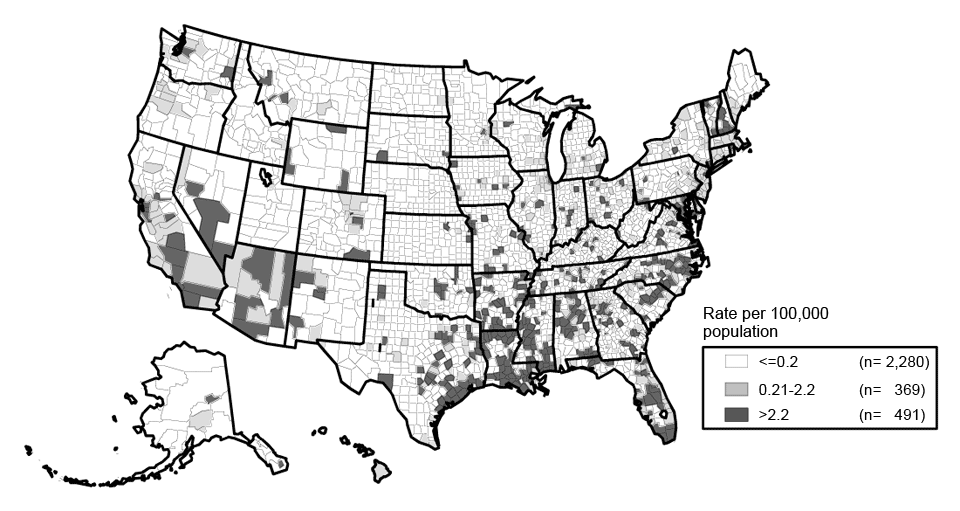
Age
In 2007, the rate of primary and secondary syphilis was highest in persons in the 25- to 29-year-old age group (8.9 cases per 100,000 population)8.
Between 2006 and 2007, primary and secondary syphilis rates in most age groups among men and women increased 8.
Impact of Gender
The rate of primary and secondary syphilis increased 17.9% among men (from 5.6 cases to 6.6 cases per 100,000 men) between 2006 and 2007 9. During this time, the rate increased 10.0% among women from 1.0 to 1.1 cases per 100,000 women 10.
By Sex & Sex Behavior
The male to female rate ratio for primary and secondary syphilis has risen steadily since 1996 when it was 1.2, suggesting an increase among MSM. In 2007, the rate of primary and secondary syphilis in males was 6.0 times that in females, an increase from 5.7 in 2006.
In 2005, CDC began collecting information on the sexual orientation of patients with primary and secondary syphilis. In 2007, this information was available for 79% of male cases.
In 2007, the stage of disease was reported as follows: among heterosexual men with primary and secondary syphilis, 43.0% had primary syphilis and 57% had secondary syphilis. Among female patients, 17.9% had primary syphilis and 82.1% had secondary syphilis. Among men who had sex with men with primary and secondary syphilis, 24.3% had primary syphilis and 75.7% had secondary syphilis.
Of females with primary and secondary syphilis, 21.9% were white, 63.5% were black, 9.6% were Hispanic, and 5.0% were of other races/ethnicities. Of heterosexual men, 19.3% were white, 59.8% were black, 16.1% were Hispanic, and 4.8% were of other race/ethnicities. Of men who had sex with men, 40.8% were white, 33.2% were black, 19.3% were Hispanic, and 6.7% were of other races/ethnicities.
Race and Ethnicity
From 2006 to 2007, the rate of primary and secondary syphilis increased in all racial and ethnic groups except Asian/Pacific Islanders. The rate increased 5.3% among non-Hispanic whites (from 1.9 to 2.0), 25% among blacks (from 11.2 to 14.0), 22.9% among Hispanics (from 3.5 to 4.3), and 6.3% among American Indian/Alaska Natives (from 3.2 to 3.4). The rate remained the same at 1.2 cases per 100,000 population among Asian/Pacific Islanders 11.
By Race/Ethnicity and Sex
From 2006 to 2007, the primary and secondary syphilis rate among non-Hispanic white males increased 5.7% (from 3.5 to 3.7), and increased among non-Hispanic white females as well (from 0.3 to 0.4). The rate increased 28.2% among black males (from 18.1 to 23.2) and 14.3% among black females (from 4.9 to 5.6). The rate increased 25.0% among Hispanic males (from 6.0 to 7.5), but remained unchanged among Hispanic females (0.8). The rate remained unchanged for both Asian/Pacific Island males (2.4), and Asian/Pacific Island females (0.1). The rate increased 36.8% among American Indian/Alaska Native females (from 1.9 to 2.6), but decreased 8.5% among American Indian/Alaska Native males (from 4.7 to 4.3) 11.
By Race/Ethnicity, Age, and Sex
In 2007, the rate of primary and secondary syphilis among blacks was highest among women aged 20 to 24 years (16.0) and among men aged 20 to 24 years (57.5) and 25 to 29 years (57.4). For non-Hispanic whites, the rate was highest among women aged 20 to 24 years (1.1) and among men aged 40 to 44 years (10.4). For Hispanics, the rate was highest among women aged 20 to 24 years (2.3) and among men aged 40 to 44 years (15.5). For Asian/Pacific Islanders, the rate was highest among women aged 20 to 24 years and 30 to 34 years (both 0.4) and among men aged 25 to 29 years (5.8). For American Indian/Alaska Natives, the rate was highest among women aged 25 to 29 years (7.8) and among men aged 30 to 34 years (18.2) 11.
References
- ↑ INGRAHAM NR (1950). "The value of penicillin alone in the prevention and treatment of congenital syphilis". Acta Dermato-venereologica. Supplementum. 31 (Suppl. 24): 60–87. PMID 14829195.
|access-date=requires|url=(help)
